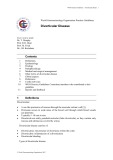
Pathophysiology and management
-
Document presentation of content: Methodology, literature review, and rationale, pathophysiology, epidemiology, natural history, risk factors, diagnosis and differential diagnosis, management of varices and hemorrhage, guidelines, further reading, and websites.
 17p
17p  vovanvovan2013
vovanvovan2013
 13-05-2016
13-05-2016
 45
45
 3
3
 Download
Download
-
Document introduction of content: Definitions, epidemiology, etiology, pathophysiology, medical and surgical management, other forms of diverticular disease, global aspects, references, useful web sites, WGO Practice Guidelines Committee members who contributed to this guideline.
 16p
16p  vovanvovan2013
vovanvovan2013
 13-05-2016
13-05-2016
 69
69
 4
4
 Download
Download
CHỦ ĐỀ BẠN MUỐN TÌM














